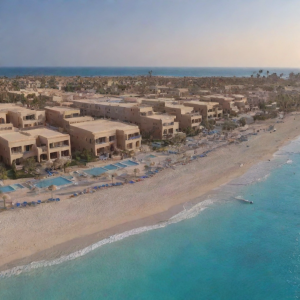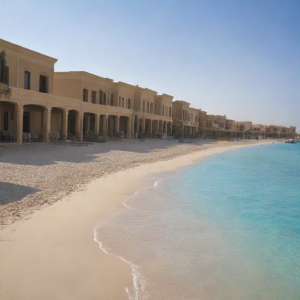Summary about owning and buying property in Hurghada, Egypt.
- With the Egyptian government and private sector investing in new resorts, airports, and road networks, Marsa Alam is quickly evolving into a full-fledged holiday escape.
- Sustainability initiatives and a focus on art and culture make El Gouna a compelling alternative for discerning visitors who want both relaxation and sophistication.
- New hotels, eco-lodges, and cultural tours are adding variety to the tourism portfolio, making this an emerging market with potential for helping Kenya close the gap with Hurghada.
- Southeast Asia continues to shine as a global tourism powerhouse, but some lesser-known beach destinations in the region are poised to challenge Hurghada’s appeal.
- In the Philippines, the island of Siargao is breaking out from being solely a surfer’s paradise into a broader tourist destination with world-class resorts and vibrant nightlife.
Emerging markets that could compete with Hurghada by 2027: key destinations to watch
Rising coastal gems along the red sea
Hurghada has long been known as a vibrant tourist hotspot on the Egyptian Red Sea coast, drawing travelers with its pristine beaches and underwater wonders. However, by 2027, several emerging markets in the same region are showing strong potential to rival this iconic destination. Locations such as Marsa Alam and El Gouna are gaining traction due to their combination of natural beauty, improved infrastructure, and increasing international investment.
Marsa Alam, located further south along the Red Sea, offers untapped coral reefs and marine biodiversity that appeal to divers and eco-tourists alike. With the Egyptian government and private sector investing in new resorts, airports, and road networks, Marsa Alam is quickly evolving into a full-fledged holiday escape. Its quieter atmosphere compared to Hurghada is especially attractive for travelers seeking a more relaxed, authentic beach experience without the mass tourism vibe.
El Gouna, on the other hand, represents a more upscale and sustainable approach to tourism development. This purpose-built town features modern marinas, luxury hotels, and golf courses. Sustainability initiatives and a focus on art and culture make El Gouna a compelling alternative for discerning visitors who want both relaxation and sophistication. Its closer proximity to Hurghada means it benefits from an established travel route, yet it maintains a distinctive charm that could pull more tourists by 2027.
Expanding opportunities in east africa’s coastal markets
Beyond Egypt, East African countries are emerging as formidable contenders in the coastal tourism race. Kenya and Tanzania, in particular, are harnessing their stunning Indian Ocean shorelines to attract visitors away from more traditional seaside resorts. The increased pace of infrastructure development, improved security, and international partnerships are fueling this growth.
Watamu Bay on Kenya’s coast is becoming a top choice for beach lovers and snorkeling enthusiasts. The Watamu Marine National Park offers a rich underwater ecosystem comparable to the Red Sea’s coral reefs. New hotels, eco-lodges, and cultural tours are adding variety to the tourism portfolio, making this an emerging market with potential for helping Kenya close the gap with Hurghada.
Meanwhile, in Tanzania, Pemba Island and the Zanzibar Archipelago have surged in popularity. These tropical paradises boast white sandy beaches, crystal-clear waters, and vibrant cultural experiences. Increased air connectivity and expanded luxury resorts contribute to positioning these destinations as strong competitors. By 2027, investments in sustainable tourism and community-based initiatives could make these locations even more appealing for responsible travelers.
Hidden treasures in southeast asia
Southeast Asia continues to shine as a global tourism powerhouse, but some lesser-known beach destinations in the region are poised to challenge Hurghada’s appeal. Countries such as Vietnam, the Philippines, and Myanmar harbor coastal areas with rapid growth driven by rising middle-class travelers and improved accessibility.
Phu Quoc Island in Vietnam is one standout. Once a quiet, fishing village, Phu Quoc is evolving into a bustling resort island complete with international airlines connecting directly to major cities. Its blend of forest-covered hills and clear bays offers a diverse experience that could rival the Red Sea’s allure. The government’s push toward eco-tourism makes it especially attractive for visitors who want sustainable yet luxurious getaways.
In the Philippines, the island of Siargao is breaking out from being solely a surfer’s paradise into a broader tourist destination with world-class resorts and vibrant nightlife. Its natural lagoons and mangroves add unique eco-tourism options that appeal to adventure and nature lovers alike.
Myanmar’s Ngapali Beach is another contender, known for its serene atmosphere and palm-lined shores that are beginning to attract international hotel chains. As Myanmar gradually opens up to more tourists, Ngapali is expected to develop rapidly, potentially providing a quieter but equally mesmerizing alternative to Hurghada.
Key factors driving competition among emerging coastal markets
- Infrastructure Improvements: Access via international airports, quality roads, and reliable public services are critical for attracting tourists.
- Sustainable Tourism Development: Destinations focusing on eco-friendly practices and community involvement are becoming more popular with conscious travelers.
- Diverse Recreational Offerings: Beaches combined with cultural experiences, water sports, golf, or wellness activities help emerging markets differentiate themselves.
- Safety and Political Stability: Tourists prefer destinations where they feel secure and confident, influencing their choice heavily.
By weighing these factors, travelers will likely see new sun-and-sea alternatives rivaling the well-established Hurghada by 2027. Whether it’s the quiet coral gardens of Marsa Alam, the luxury charm of El Gouna, the vibrant coasts of East Africa, or Southeast Asia’s hidden paradise islands, the global map of beach tourism is shifting in exciting ways.
Factors driving the growth of new coastal tourism hubs beyond Hurghada
The rapid expansion of coastal tourism is reshaping the vacation landscape, and while Hurghada remains a top destination, emerging markets are gaining significant traction. Various factors collectively contribute to the growth of these new coastal tourism hubs, positioning them as potential competitors to established locations by 2027.
Strategic geographic positioning and accessibility
Location plays a crucial role in attracting visitors. Many rising coastal destinations offer unique geographic advantages that appeal to tourists seeking alternative experiences beyond the popular hubs. Proximity to major cities, international airports, and well-developed transport networks make these locations increasingly accessible.
Investments in infrastructure, such as new airports or upgraded ports, further enhance accessibility. This can reduce travel time and costs, broadening the appeal to both regional travelers and international tourists. For example, coastal areas near emerging economies are seeing improvements in connectivity, which is vital for expanding tourism markets.
Investment in sustainable and eco-friendly tourism
With growing global awareness about environmental conservation, travelers today demand responsible tourism options. Coastal locations that prioritize sustainability are attracting eco-conscious tourists. These destinations integrate conservation efforts with tourism development, promoting activities that support marine life and protect fragile ecosystems.
Developers are incorporating green technologies and practices into resorts and attractions, reducing the environmental footprint. Destinations promoting snorkeling, diving, and wildlife observation alongside ecological preservation are witnessing increased popularity.
Unique cultural and local experiences
Modern tourists often seek authentic cultural engagement alongside leisure. New coastal tourism hubs that preserve and showcase their heritage while offering modern amenities stand out. Visitors appreciate festivals, artisanal markets, traditional cuisines, and historical sites that heighten the overall travel experience.
Collaborations between local communities and tourism operators help maintain cultural integrity while generating income. This emphasis on cultural tourism adds richness to these emerging destinations, distinguishing them from more commercialized spots like Hurghada.
Government policy and incentives
Proactive government support can rapidly accelerate destination growth. Many emerging coastal tourism areas benefit from policies that encourage foreign investment, reduce taxes, and streamline permitting processes for tourism-related projects.
Additionally, promotional campaigns highlighting lesser-known coastal gems raise awareness. Governments may also focus on security enhancements and improve public services, increasing the confidence of international travelers.
Affordability and value for money
Competitive pricing remains a powerful draw. Emerging coastal markets often offer attractive accommodation, food, and activity options at lower costs compared to established resorts. This value proposition appeals especially to budget-conscious tourists and families looking for quality experiences without the premium price tag.
As these destinations develop, they tend to maintain cost advantages while improving service quality, making them compelling alternatives to pricey holiday hotspots.
Expanding range of tourism activities
Beyond beaches and water sports, these growing coastal hubs are diversifying their tourism offerings. Adventure tourism, wellness retreats, culinary tours, and cultural workshops are just some examples of activities broadening the appeal.
This diversification attracts a wider spectrum of visitors and encourages longer stays. The ability to cater to different interests positions emerging coastal destinations as versatile and dynamic tourism hubs.
Technological integration for enhanced tourist experience
Technology is increasingly shaping how travelers choose and enjoy their vacations. Emerging markets that leverage digital platforms for seamless booking, virtual tours, language assistance, and personalized itineraries gain a competitive edge.
Smart tourism initiatives employing apps, AI, and data analytics improve convenience and satisfaction. They also enable these coastal destinations to reach global audiences effectively, making them top-of-mind options for future travel plans.
Key factors summarized
- Improved Accessibility: Enhanced infrastructure and transport links.
- Sustainability Focus: Eco-conscious tourism practices drawing a modern audience.
- Cultural Authenticity: Emphasis on local heritage and immersive experiences.
- Supportive Policies: Government incentives and promotional efforts.
- Cost Efficiency: Affordable travel options without compromising quality.
- Diverse Activities: Broad range of leisure and adventure offerings.
- Technology Use: Digital tools enhancing travel accessibility and convenience.
As these factors converge, it’s clear that new coastal tourism hubs are positioned to challenge the dominance of traditional spots like Hurghada by 2027. Travelers seeking fresh, affordable, and meaningful experiences will naturally gravitate toward these burgeoning destinations. With continued investment and thoughtful development, these emerging markets will offer compelling alternatives that combine natural beauty, cultural richness, and modern amenities to meet evolving tourist desires.
As the global travel landscape evolves, several emerging markets are poised to challenge Hurghada’s dominance by 2027. Destinations offering stunning coastlines, rich cultural experiences, and improved infrastructure are capturing the attention of travelers seeking new adventures. Places like Madagascar, Albania, and certain regions in the Philippines are gaining popularity due to their unique blend of natural beauty and increasing accessibility.
The growth of these coastal tourism hubs stems from multiple driving factors. Improved transportation links, including new airports and better road networks, make reaching these locations easier than ever. Additionally, rising investments in sustainable tourism practices ensure these destinations can offer attractive experiences while protecting their environment. Governments and local communities are also playing vital roles, fostering welcoming environments and promoting authentic cultural engagement that modern travelers crave.
By recognizing these emerging markets and understanding what fuels their rise, you gain insight into the future of coastal tourism beyond Hurghada. Whether you are a traveler looking for fresh, less crowded beach experiences or an industry professional tracking tourism trends, these new hotspots offer exciting opportunities worth watching. As more destinations invest in quality services and infrastructure, the competition will encourage innovation and elevate the entire region’s appeal, promising an enriched travel experience for years to come.










